ASUS N53JF: Midrange 15.6” 1080p, Take Four
by Jarred Walton on December 28, 2010 1:40 AM ESTASUS N53JF: Performs as Expected
Performance is pretty much right where you’d expect, given the hardware. It has the same GT 425M GPU as the Clevo B5130M and the i5-460M CPU is fractionally faster than the i5-450M in the XPS 15, so performance typically falls in between the two. Battery life is somewhat hampered by ASUS’ continued use of 48Wh batteries in their N-series, something we’ve complained about in the past. The U-series’ 84Wh batteries don’t feel much heavier than the 48Wh, and size is close enough that a slight reworking of the N53JF could have accommodated the larger battery. However, ASUS does do a reasonable job at power management, so even with a smaller battery than the competition it remains competitive. Here are the application results, followed by gaming and battery life.
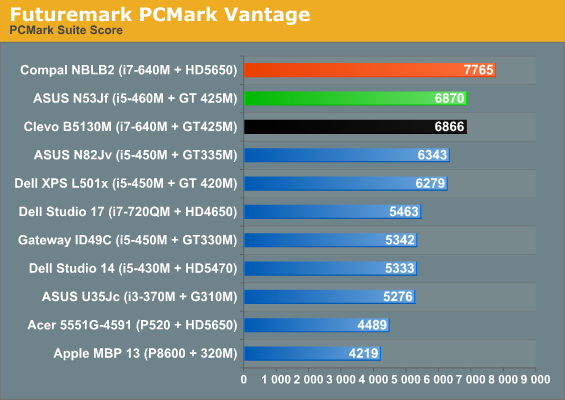
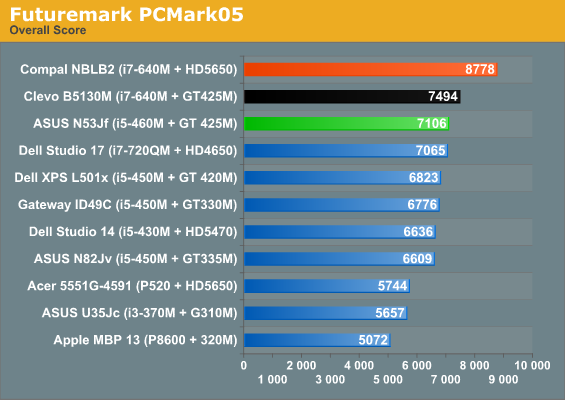
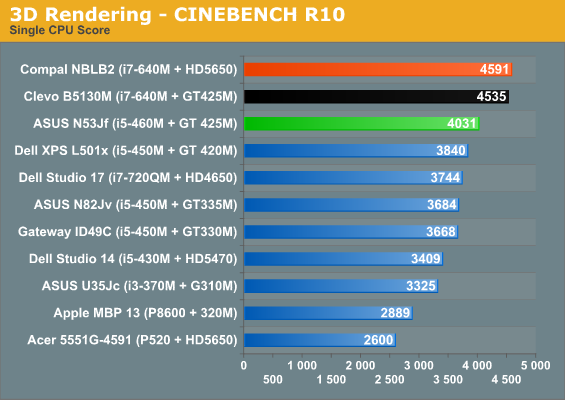
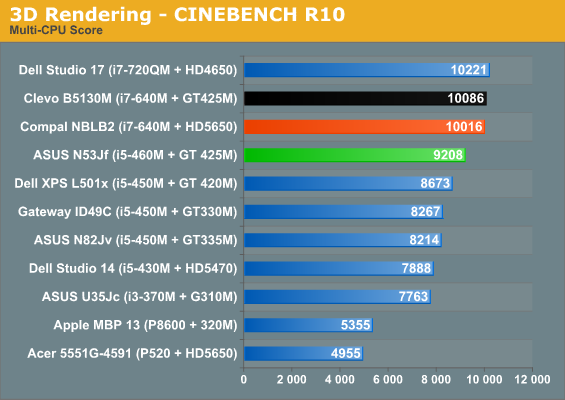
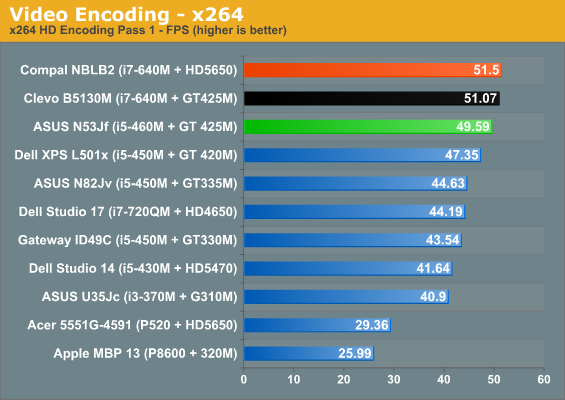

Starting with these general performance metrics, the N53JF is usually about 5% faster (sometimes as much as 10%) than the XPS 15, which goes with the CPU upgrade, with perhaps a few extra performance optimizations by ASUS. The Clevo and Compal laptops both have a faster i7-640M CPU so they come out ahead, but other differences come into play. In PCMark, the Clevo and ASUS laptops are nearly equal, but the Compal comes out 13% faster in Vantage and 23% faster in PCMark05—perhaps thanks to the HD 5650 discrete GPU. Once we hit the pure CPU tests of 3D rendering and video encoding, the charts fall into line and the i7 CPU outpaces the i5-460M by 8-10%.
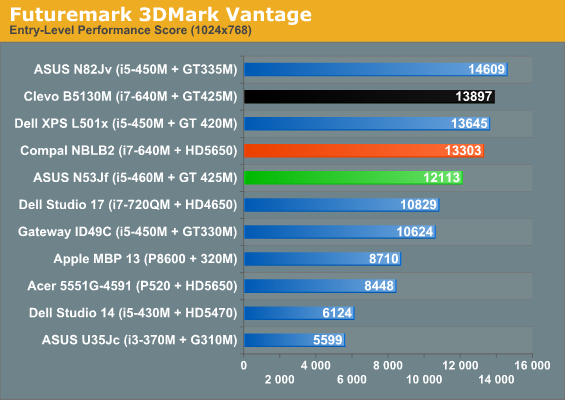
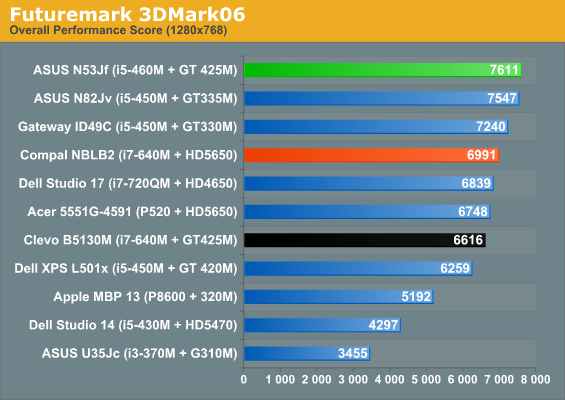
3DMark numbers aren’t a major focus for us, for good reason. Here we see the N53JF leading by up to 22% in 3DMark06, but then it trails by up to 15% in Vantage. Yeah, go figure. The Performance score in Vantage is 3559 for the curious. The 3DMark03/05 numbers aren’t any better (no graphs on those): 16612 in 03 and 13397 in 05 put it slightly ahead of the Clevo and Dell laptops, but the HD 5650 is 3% faster in 05 and 30% faster in 03. The reason for the large lead in 03 is that Optimus appears to be a bottleneck on ultra-high frame rates; the PCIe bus gets saturated, so when you start to try and push more than ~150FPS (i.e. in the Wings of Fury benchmark) you hit a hardware frame rate bottleneck. Given the level of hardware and the frame rates where this manifests, however, it’s nothing we’re concerned about—it should only show up in older titles that really don't stress the GPU much.










65 Comments
View All Comments
Kaboose - Wednesday, December 29, 2010 - link
i sure hope that is why there isn't a single dell laptop offering a 1080p screen at the moment. (including alienware taxed items)chemist1 - Tuesday, December 28, 2010 - link
Hi Jarred,Thanks for the review. A friend of mine recently priced out a Sony Vaio F series laptop: 16.4" 1080p screen, Blu-Ray R/W drive, NVIDIA GeForce GT 425M GPU, and an Intel Quad Core i7-840QM Processor (1.86GHz, turbo up to 3.20GHz) ---he said it was about $1300. Perhaps that is worth a review.....
cgeorgescu - Tuesday, December 28, 2010 - link
Very nice laptop... Check out the "premium" screens on all Vaio models, really nice, not led-backlight or any fancy stuff but perfect angles, 100% adobe RGB, perfect. And matte.I've got not the F but the EC because of 17.3 instead of 16.4 and two drive bays.
chemist1 - Tuesday, December 28, 2010 - link
correction: just checked it myself, and it's $1300 (on the Sony site) with a Core Quad i7-740QM processor (1.73GHz with turbo up to 2.93GHz).The EC series cgeorgescu mentioned might be an even better buy. With a 1080p 17.3" screen (a bit more suitable for 1080p than the F's 16.4) , Blu-Ray R/W, ATI HD 5650 (don't know how that compares with the 425M on the F series), and Core i5-580M processor (2.66GHz, with turbo to 3.33GHz ) (Core i7 not offered on the EC series), it prices out to $1200.
And, as with the F series, if you downgrade from a Blu-Ray RW to a CV/DVD RW, you can subtract $150.
chemist1 - Tuesday, December 28, 2010 - link
Further, if we downgrade the EC series to make it comparable to the Asus reviewed here (Blu Ray read only + CD/DVD RW, Core i5 460, 1080p), the Sony site has it at $1020 --- nearly the same as the $1030 Asus but with what I understand is a much better screen (plus the extra drive bay that cgeorgescu mentioned, and the free Adobe Acrobat/Photoshop bundle).JarredWalton - Tuesday, December 28, 2010 - link
Don't forget that quad-core Clarksfield CPUs are horribly power inefficient, so you'd sacrifice quite a bit of battery life. Given that Sandy Bridge will address this, there's basically no point in looking at any more Core 2010 or Clarksfield laptops.chemist1 - Wednesday, December 29, 2010 - link
Understood, thanks for your reply. But that leaves unanswered the obvious follow-up question, which is that of why, given that these Vaios have been out for a while, and given that they may represent the best value available in ~$1K laptops (say, the dual-core EC series), you folks didn't include them among your recent looks at mid-range laptops (e.g., the Vaios weren't mentioned in your 11/15/10 "Holiday Buyer's Guide: Notebooks"). Did you consider them and discount them for some reason, or was it something else? Since choosing what to review from amongst a large universe of products is a significant part of what a tech journalist must do, I was just wondering what goes into these sorts of decisions.JarredWalton - Wednesday, December 29, 2010 - link
The biggest issue is that Sony basically has no interest in seeding reviewers with hardware. While you could try to buy/review/eBay laptops, I don't have enough time/money to go that route, and we've been busy with other items. We did mention the VAIO Z in the guide, but most of the time I have difficulty justifying the Sony Tax. And not all Sony laptops have good displays either -- I've looked at more than a few at Best Buy, etc. Without hands-on time or input from someone I trust, I'm not willing to recommend a laptop as having a good LCD. :-\I'll see if I can get Sony to be a little more forthcoming at CES, but I've gone down that road before to no avail.
chemist1 - Wednesday, December 29, 2010 - link
Thanks for the explanation! Why there had been no review of this particular (and seemingly high-value) part of the Vaio line was something I'd been curious about for a while, so it's nice to understand the manufacturer's role in this (a factor I had not considered).Hrel - Tuesday, December 28, 2010 - link
You guys and ur glossy bezel on the screen. Put ur thumb on the edge of the screen to open the laptop, there, problem solved. lol. wow.Other than that nit-picky sillyness I was REALLY saddened to see those low scores on that Asus. I read it had to same display as the Dell used to and got all excited then those scores... I guess they had to save money somewhere to hit 1000 bucks AND have a blu ray drive. Honestly, I almost never use disks at all anymore and have never even touched a blu ray disc. Don't include any CD drive at all, put in a bigger battery and better screen and non-name-brand speakers that don't suck and I'd be good. If the marketing guys insist on a cd drive use the cheapest one you can find.